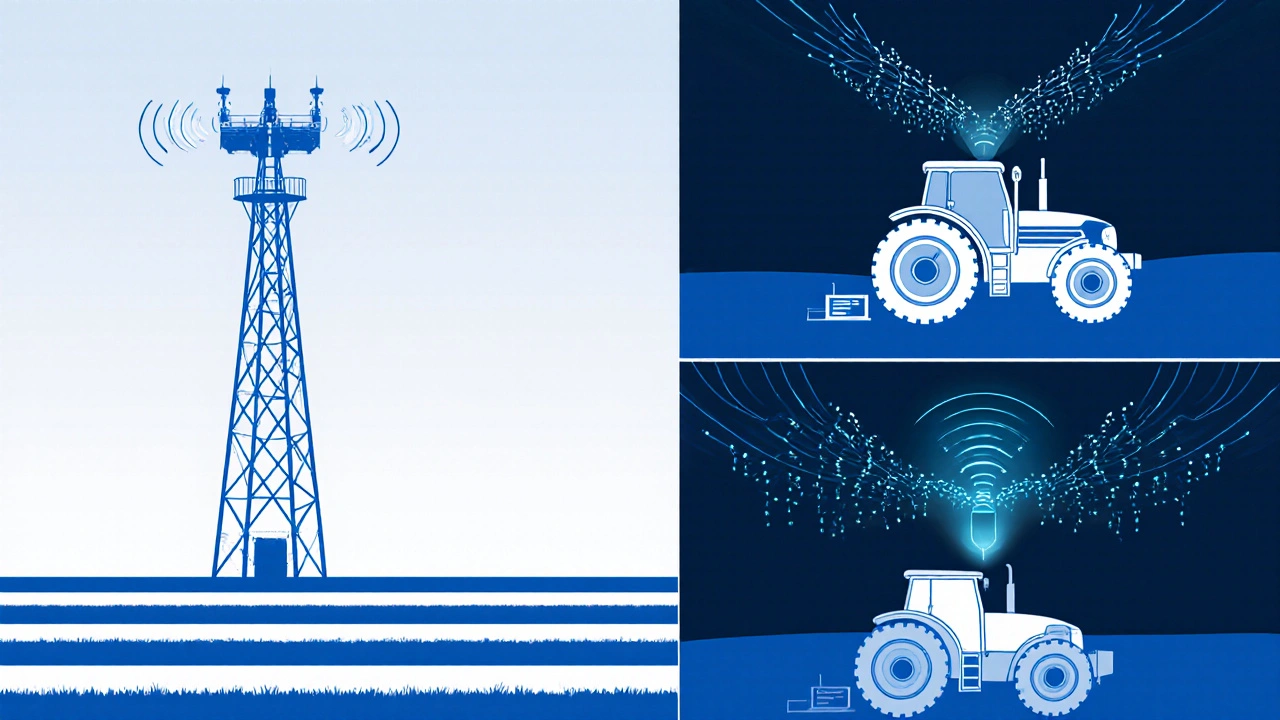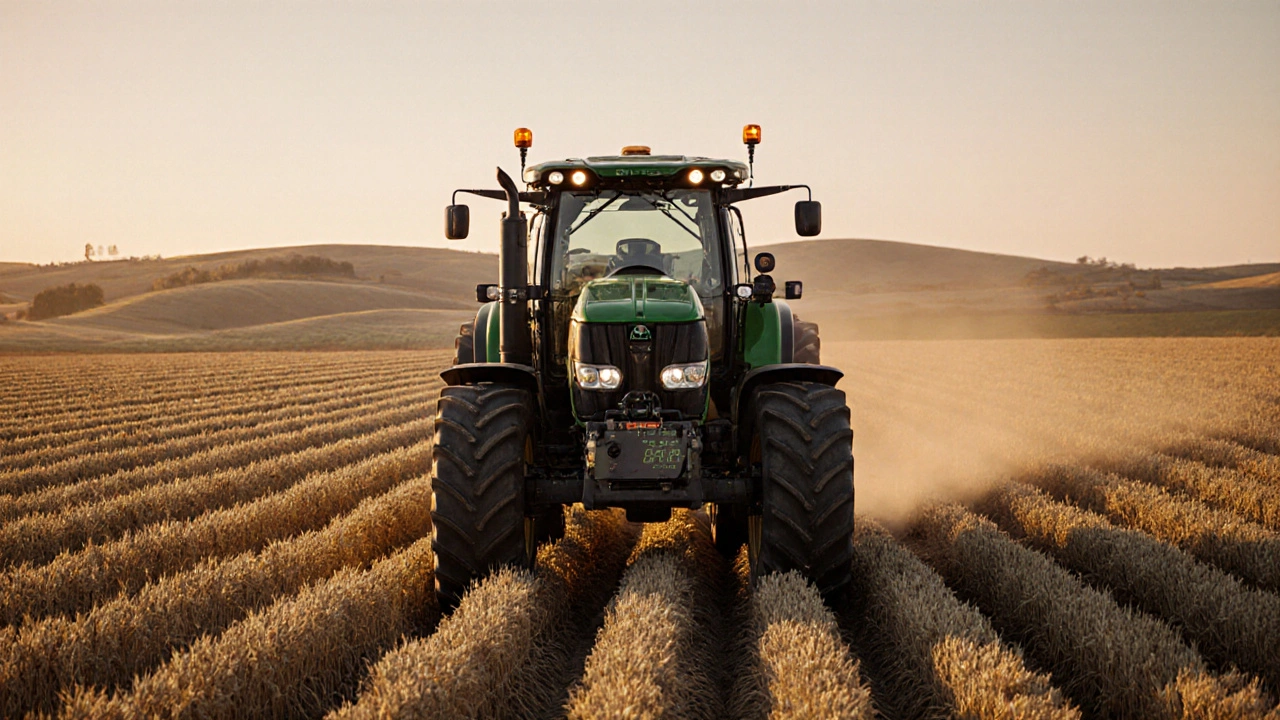Why Farmers Are Switching to RTK Guidance
Imagine driving a tractor down a 100-acre field and hitting the same spot every time - not just close, but within 1 inch. That’s not science fiction. It’s what farmers using Real-Time Kinematic (RTK) guidance systems do every day. Before RTK, GPS in agriculture was good enough to keep you from driving into the ditch, but not good enough to stop you from spraying fertilizer on the same patch of soil twice. Now, with centimeter-level accuracy, farmers are cutting seed, chemical, and fuel waste by up to 20%. And yields? They’re going up by 5-10% without planting another seed.
RTK isn’t just a better GPS. It’s a complete overhaul of how machines move through fields. Standard GPS gives you accuracy within 5 to 10 meters. That’s fine for hiking or driving on a highway. But in a wheat field, that’s a 30-foot margin of error. You’re overlapping passes, missing rows, and wasting inputs. RTK fixes that. It uses ground-based reference stations to correct satellite signals in real time, bringing accuracy down to 1-2.5 centimeters. That’s the difference between guessing where to plant and knowing exactly where every seed goes.
How RTK Works: The Three-Piece System
RTK doesn’t work alone. It needs three things: a fixed base station, a communication link, and a rover on your tractor.
- The base station sits on your farm or on a nearby network tower, locked onto a known location. It watches the satellite signals and calculates how much they’re off - maybe 30 centimeters here, 15 there. It then sends those corrections out.
- The communication link carries those corrections to your tractor. This can be through radio (like John Deere’s 900 MHz system), cellular networks, or internet-based NTRIP. In rural Australia, radio is still king because cell towers are sparse. In Iowa or the Netherlands, cellular networks are dense enough to handle the load.
- The rover - mounted on your steering wheel or dashboard - receives those corrections and adjusts the tractor’s path in real time. It doesn’t just show you where to go. It tells the auto-steer system to turn the wheels just enough to stay on track. No drifting. No overlaps. No gaps.
CHCNAV’s 2025 specs confirm this system delivers 1-2.5 cm accuracy under ideal conditions. South Plains Implement’s users report 1-inch pass-to-pass precision - meaning if you drive the same row twice, your tires will follow the exact same groove. That kind of consistency is what makes variable-rate application possible. You can apply fertilizer only where it’s needed, not everywhere.
RTK vs. Other Systems: Why It Beats the Rest
There are other ways to get better GPS in farming. But none match RTK’s speed and precision.
| System | Accuracy | Setup Time | Range | Best For |
|---|---|---|---|---|
| Standard GPS | 5-10 meters | Instant | Global | Basic field mapping |
| Satellite Augmentation (WAAS) | 50-100 cm | Instant | Continental | Small-scale operations |
| Precise Point Positioning (PPP) | 2-5 cm | 20-30 minutes | Global | Remote areas, no base stations |
| RTK | 1-2.5 cm | <1 minute | 10-15 miles from base | High-precision planting, spraying, harvesting |
PPP sounds great - global coverage, no base station needed. But if you’re planting soybeans at dawn and your system takes 25 minutes to lock in, you’ve lost half your day. RTK locks in under a minute. That’s why it’s the standard for commercial farms. Even Premium Positioning’s network of over 1,000 base stations across Europe only covers a few hundred miles per station. But within that range, accuracy is rock-solid.

Real Savings: What Farmers Are Actually Saving
It’s not just about precision. It’s about money.
On Reddit, a farmer from Nebraska named MidwestFarmer87 posted that after installing RTK, his seed overlap dropped from 8% to 0.5%. On 300 acres, that saved him $2,300 in seed costs alone. FieldBee’s 2023 survey of 2,100 users found an average savings of $18.75 per acre on fertilizer and chemicals. Multiply that by 1,000 acres, and you’re talking $18,750 saved in one season.
But it’s not just inputs. RTK cuts fuel use by reducing unnecessary passes. One study showed a 12% drop in diesel consumption. Combine that with reduced tire wear and less soil compaction from overlapping wheels, and the savings stack up. The American Society of Agricultural and Biological Engineers (ASABE) gave RTK their 2022 Innovation of the Year because it didn’t just make farming easier - it made it cleaner. Less chemical runoff. Less soil damage. Less waste.
And yields? They’re climbing. Not because you’re planting more, but because you’re planting better. Every row is straight. Every seed is spaced correctly. Every drop of herbicide hits the weed, not the crop. That’s how you get 5-10% more bushels per acre.
Who Can Afford It? The Cost Barrier
Here’s the catch: RTK isn’t cheap.
Dr. Sarah Thompson from the University of Illinois found that the upfront cost for a full RTK setup - receiver, antenna, display, subscription - runs between $5,000 and $15,000. For a 2,000-acre operation, that’s an easy ROI in under two seasons. But for a 200-acre family farm? It’s a tough sell.
That’s why adoption rates vary wildly. In North America, 65% of large farms (over 500 acres) use RTK. In Europe, it’s 42%. In developing countries? Just 18%. The FAO says cost and lack of infrastructure are the biggest barriers.
But things are changing. Companies like CHCNAV and ArduSimple now offer entry-level RTK kits under $3,000. Network providers like Premium Positioning let you pay for coverage by the acre instead of buying your own base station. Some cooperatives in Australia and Kansas are even pooling resources - buying one base station and sharing corrections among 10 farms. That’s cutting the cost per farmer by 70%.

What Can Go Wrong? The Real Challenges
RTK is powerful, but it’s not magic. It has limits.
- Signal loss: If you’re farming in a valley with tall trees or near metal silos, the satellite signal can drop. Even a 10-second interruption can cause your tractor to drift. Newer systems like CHCNAV’s 2025 model handle partial obstructions better, but they still need a clear view of the sky.
- Network dependence: If your cellular signal dies or your radio link fails, you lose corrections. In remote parts of South Australia, farmers still rely on radio. In the Midwest, cellular is fine - until a storm knocks out the tower.
- Setup complexity: One user on Trustpilot said, “The first season was frustrating with constant signal drops.” That’s common. Getting the base station aligned, the rover calibrated, and the software synced takes time. But most farmers say they’re comfortable after 2-3 field days.
- Solar storms: The USDA warned in 2023 that extreme solar activity can disrupt GNSS signals. It’s rare, but if it happens during harvest, you’re stuck with manual steering.
Still, the reliability is high. Premium Positioning’s network runs at 99.9% uptime. CHCNAV’s documentation gets 4.7 out of 5 stars for clarity. And support? Their average response time is 8 minutes. That’s better than most phone carriers.
What’s Next? The Future of RTK Farming
RTK isn’t standing still. It’s getting smarter.
Farmonaut’s 2023 update links RTK positioning with satellite imagery to create real-time nutrient maps. Your tractor doesn’t just follow a line - it knows exactly where the soil is low in nitrogen and adjusts the fertilizer rate on the fly. That’s precision farming at its best.
CHCNAV’s new system, released in April 2025, maintains 2.5 cm accuracy even when trees block half the sky. Premium Positioning is adding 500 more base stations across Europe by mid-2026. And McKinsey predicts 85% of commercial farms over 250 acres in developed countries will be using RTK by 2030.
The trend is clear: farming is becoming a data-driven industry. RTK is the foundation. It’s not just about where your tractor goes. It’s about what your farm knows - and what it can do with that knowledge.
Getting Started: What You Need Today
If you’re thinking about RTK, here’s what to do:
- Check your coverage: Use a map from Premium Positioning, CHCNAV, or your local provider. If you’re within 15 miles of a base station, you’re good to go.
- Choose your setup: Do you want to buy your own base station (expensive but independent) or subscribe to a network (cheaper, but you’re tied to them)?
- Start small: Install RTK on one tractor first. Use it for planting or spraying. See how much you save before rolling it out to the whole fleet.
- Train your team: Most systems are intuitive now, but a 2-hour training session from your dealer can cut setup time in half.
- Track your results: Record your seed, chemical, and fuel use before and after. The numbers will speak louder than any sales pitch.
RTK isn’t just a tool. It’s a shift in how we think about land. It turns guesswork into control. And for farmers who want to do more with less - it’s no longer optional. It’s essential.


12 Responses
I've been using RTK for three seasons now. My fuel bill dropped 15% and I'm not over-spraying anymore. Best investment I ever made.
This is why America leads in ag tech. Other countries are still using horse-drawn plows while we're guiding tractors with satellite precision.
RTK is the real MVP of precision ag. You get centimeter-level accuracy, zero overlap, and your auto-steer doesn't drift like a drunk guy at a county fair. The 2025 CHCNAV units? Absolute beasts. Just make sure your radio link isn't trash.
The economic and environmental benefits of RTK technology are truly remarkable. By minimizing input waste and maximizing yield efficiency, farmers are not only improving their bottom line but also contributing to sustainable land stewardship. This innovation deserves widespread adoption.
I'm curious how RTK performs on hilly terrain. The article mentions signal loss near trees and silos, but what about rolling land? Does the rover compensate for elevation changes as well as lateral drift?
I appreciate how this article breaks down the technical aspects without oversimplifying. The comparison table is especially helpful. RTK isn't magic-it's engineering, and it works.
I've seen farmers spend $12k on RTK and then never update the firmware. The system's useless if you don't maintain it. Just saying.
In India, we dream of this. Our tractors still follow the last guy's wheel tracks. But I'm saving up. One day.
I just love how this tech turns farming from guesswork into science... it's so satisfying to see every row perfectly aligned, you know? Like a quilt made by machines... :)
You people are so naive. RTK? Please. It's a glorified GPS toy for rich white guys who think they're Elon Musk. Real farmers still use a plumb line and a beer can. This 'precision' is just corporate propaganda to sell overpriced gadgets.
I tried RTK last year and my tractor glitched during harvest and I almost crashed into my neighbor's prize-winning corn... I cried for three days. This tech is a trap. Don't do it.
You're all missing the point. RTK doesn't just save money-it reduces soil compaction, which improves water retention and root growth. That's not just efficiency. That's ecological responsibility. And if you're still using WAAS in 2025, you're doing farming wrong.